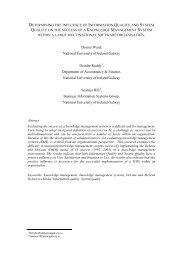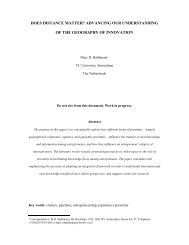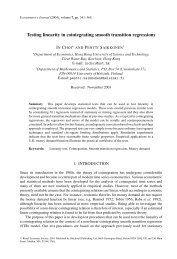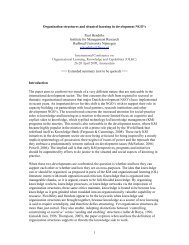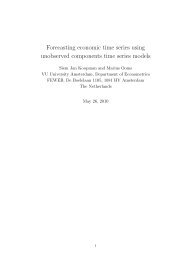The effects of road pricing - Feweb - Vrije Universiteit Amsterdam
The effects of road pricing - Feweb - Vrije Universiteit Amsterdam
The effects of road pricing - Feweb - Vrije Universiteit Amsterdam
You also want an ePaper? Increase the reach of your titles
YUMPU automatically turns print PDFs into web optimized ePapers that Google loves.
they are prepared to pay at least the marginal social costs involved. This fear has been<br />
explicitly high in the transport market leading to widespread price regulation in many<br />
sectors by numerous governments.<br />
A ‘first-best optimum’, where all prices equate marginal social costs, will prevail as a<br />
market equilibrium under certain conditions, among which:<br />
- perfect competition;<br />
- no distortions in other market segments;<br />
- no externalities;<br />
- complete information about future prices, tastes and technology;<br />
- no subsidies or indivisibilities <strong>of</strong> demand or supply.<br />
An allocation is said to be first-best if it maximises social welfare subject to the<br />
irreducible technological constraints <strong>of</strong> production (Dreze and Stern, 1987). A firstbest<br />
optimum in transport is an allocation defined by quantities <strong>of</strong> goods, including<br />
passenger and freight transport volumes, that maximises W ( . ) , given the prevailing<br />
technology, such as vehicle fuel consumption and emissions, and the capital stock,<br />
including transport infrastructure (MC-ICAM, 2002). This definition encompasses<br />
externalities if their costs are internalised in the decisions <strong>of</strong> agents who generate<br />
them and included in their utility functions. Economic efficiency then implies that the<br />
full costs <strong>of</strong> transport services are accounted for, including social and environmental<br />
costs (no externalities). Including these social and environmental costs in the welfare<br />
function is difficult, but estimates <strong>of</strong> the most important externalities exist (see also<br />
Section 2.4.2).<br />
2.3.2 Social welfare and equity<br />
From the previous discussions it becomes clear that, in a fully competitive and<br />
distortion free economy, each price equilibrium is a Pareto optimum. This means that<br />
the market mechanism is able to guarantee efficiency for any initial distribution <strong>of</strong><br />
resources over the population. However, this distribution might not be consistent with<br />
policy objectives and the public may perceive it as unfair. This section deals with<br />
<strong>pricing</strong> and its consequences in terms <strong>of</strong> equity. Equity is important from the<br />
viewpoint <strong>of</strong> distribution <strong>of</strong> income (or other items) and for the acceptability <strong>of</strong><br />
<strong>pricing</strong> policies by the public. Various types <strong>of</strong> equity concepts are important in<br />
transport and these will now be discussed, as well as strategies to deal with<br />
distributional issues.<br />
Equity is important in the context <strong>of</strong> the acceptability <strong>of</strong> <strong>pricing</strong>. Many stakeholders<br />
raise objections about <strong>pricing</strong> measures that they perceive to be unfair. If a <strong>pricing</strong><br />
measure is unfair either to themselves in relation to other people or to people<br />
perceived to be less well <strong>of</strong>f in society, then there could be significant acceptability<br />
problems. Transport <strong>pricing</strong> can <strong>of</strong>ten be perceived to be a form <strong>of</strong> regressive<br />
taxation, allowing only those with enough money to access a resource (e.g.<br />
infrastructure) that was once considered free. Implementation strategies are therefore<br />
discussed that allow certain sections <strong>of</strong> the community to be exempted from <strong>pricing</strong>,<br />
or compensate some groups with a lump-sum transfer. <strong>The</strong> problem <strong>of</strong> who should<br />
receive extra benefits (e.g. tax exemption) and the wider problem <strong>of</strong> making sure<br />
price measures are both equitable and perceived to be so, are important issues to be<br />
included in any successful implementation strategy. Here the concept <strong>of</strong> price<br />
discrimination shows up. In public transport, for instance, it is common that different<br />
prices are charged for the same service. <strong>The</strong> fare policy <strong>of</strong> governments may benefit<br />
particular groups <strong>of</strong> society, e.g. the elderly.<br />
14





